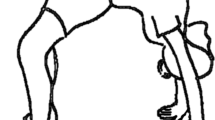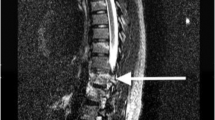Abstract
Study design:
Case report.
Objectives:
To present an interesting case of a 14-year-old male with acute paresis of upper extremities and progressive difficulty with lower extremities. The patient is a competitive wrestler and was performing his daily abdominal workout ‘sit-ups’ with hands interlocked behind his head. During the end and immediately following his abdominal workout, he felt progressive weakness in his upper extremities. He was rushed to the hospital within an hour and seen in the emergency room and admitted to the neurology service for a presumed thromboembolic event.
Setting:
New York, USA.
Results:
The patient was negative for any hematologic disease or coagulopathy. Magnetic resonance imaging was negative for any mass effect on the spinal cord and neurological examination revealed bilateral upper extremity paraparesis 3/5 and lower extremity spasticity and propioceptive dysfunction. The patient was treated with corticosteroids and rigid collar, follow-up examination at 3 months revealed resolution of symptoms.
Discussion/Conclusion:
The pathophysiology of central cord syndrome is thought to be primarily secondary to a hyperextension injury, which causes buckling of the ligamentum flavum and increasing spinal cord diameter which leads to cord compression. This syndrome is more commonly seen in the spondylotic elderly. This case involves a teenager with normal canal diameter; however, combining aggressive exercise with extreme cervical hyperflexion, one can plausibly account for an acute ischemic event or repetitive microinjury to the spinal cord.
Similar content being viewed by others
Introduction
Cervical spine injuries in teenagers is generally due to high-impact injuries with hyperextension or hyperflexion.1, 2 The cervical spine is predisposed for injuries at the C4–C6 levels due to the major levels of motion occurring at these levels.3 The primary fulcrum for flexion and extension in the cervical spine occurs in the C4–C6 levels.3 Injuries related to abdominal exercises have been reported secondary to the inevitable Valsalva maneuver that occurs with contraction of the abdominal muscles.4 There are no reports of cervical spine ligamentous or spinal cord injuries (SCI) occurring during ‘sit-ups’. The pathophysiology and biomechanics of spinal cord and cervical spine injury occurring with ‘sit-ups’ and the appropriate form in performing sit-ups to prevent injury will be reviewed.
Case report
A 14-year-old healthy male was presented with acute onset paresis of the upper extremities and gait difficulty. The patient admitted to performing abdominal exercises, ‘sit-ups’, as part of his daily workout for wrestling. During the end of his last few sit-ups, he felt tingling in his arms and shoulders, which progressed to 3/5 weakness within 10 min. He was brought to the emergency room within 1 h of symptom onset and admitted to some gait difficulty upon entering the emergency room. The neurology service was consulted and began intensive work-up for presumed vascular insult secondary to a hypercoagulable state. Plain radiographs and computed tomography scan were performed in the emergency room, which were normal (Figure 1). A magnetic resonance image of the cervical spine was performed within 24 h and revealed a normal spinal cord and no evidence of abnormalities (Figure 2). Neurosurgery was consulted on day 3 hospital admission and we immediately performed physician- supervised flexion/extension films of the cervical spine, which were also normal (Figure 3). Examination on day 3 was significant for 2/5 weakness in biceps and deltoids bilaterally with 3+/5 strength in remaining upper extremity muscle groups. Lower extremities were spastic (Ashworth 4) with difficulty in gait secondary to propioceptive difficulties in the lower extremities with right worse than left and his ASIA score was 78. The patient was placed on Decadron (dexamethasone) 4 mg every 6 h with rapid taper over five days. The patient made significant improvement over the next 24 h with 3+/5 strength in biceps and deltoids and 4/5 in remaining upper extremities and gait improved. The patient was discharged on a rapid taper of Decadron, placed in a rigid collar, instructed not to participate in any physical activity for 3 months and return for repeat magnetic resonance imaging (MRI) in 3 months. A repeat MRI revealed no changes as compared to the initial MRI and the patient had returned to normal functional status.
Discussion
Cervical spinal cord neuropraxia typically occurs in the elderly patient or athlete with predisposing spondylosis/stenosis.2, 6, 7, 8, 9, 10 Pediatric patients suffering SCI may have a congenital cervical spondylosis or craniovertebral anomaly.2, 9, 11 Studies on cervical spinal cord neuropraxia in pediatric athletes have demonstrated that congenital stenosis is not common.1, 2, 3, 11 The biomechanics of cervical SCI in pediatrics has been postulated to be secondary to hypermobility.1, 2, 11 We agree with this theory, our patient had a normal spinal canal diameter and did not demonstrate any instability on flexion-extension films. Interestingly, there is a case of flexion myelopathy in a 22-year-old patient with a 7-year history of ‘flexion tics’ of the neck, with about 40 tics per minute. Thorough radiographic examination revealed no spondylosis or degeneration but on dynamic MRI during flexion the patient had flattening of the spinal cord with dorsal compression, thought to be due to stretching of the spinal cord with subsequent compresion by the dorsal dura.12 MRI studies on juvenile flexion myelopathy revealed three possible mechanisms: (1) over-stretch of the spinal cord with hyperflexion, (2) dorsal compression by the dura, (3) arterial ischemia secondary to venous congestion during flexion.13
A brief discussion on the mechanism of injury is warranted based on the popularity of ‘sit-ups’ in the general population. Our patient was performing standard ‘sit-ups’, as performed by our own military services and numerous instructional exercise videos.14 The patient was lying supine with his fingers interlocked behind his occiput and feet flat on the ground. He attempted to touch his elbows to his knees, causing abdominal contraction but also inducing hyperflexion of the cervical spine. He performed two sets of 50 repetitions for ‘sit-ups’, experiencing neurological symptoms during his last set. Our patient had been performing these abdominal exercises for years without neurological sequelae. The patient admitted that he was fatiguing in his last set of ‘sit-ups’, which likely led to less abdominal contractions and a tendency to increase the use of the interlocked-hands behind the occiput to assist in the exercise, thus causing a hyperflexion of the cervical spine and likely inducing either repetitive microinjury to the spinal cord or ischemia. There are several reports of injuries occurring with ‘sit-ups’ including cervical spine fractures, cerebrovascular accident and a cervical spine epidural hematoma.5, 15 The numerous reports of SCI without radiographic abnormality (SCIWORA) in the pediatric population demonstrates the mobility within the spinal column in the young patient.1, 3, 16 Of interest in this case would have been the utilization of dynamic MRI to reveal any occult instability, hypermobile segments or dorsal areas of compression.17
Owing to the popularity of abdominal exercises, in particular ‘sit-ups’, we would like to recommend an alteration to standard ‘sit-ups’ that involves crossing the arms over the chest rather than behind the head to prevent such injuries in the future. This report exemplifies the occult mobility of the premature cervical spine which in most cases is a beneficial effect preventing the common fractures and injuries that occur in the adult population. However, in this instance the hypermobility was detrimental, allowing for repetitive microinjury to the cervical spinal cord. We hope that this report assists physicians that manage athletes and patients involved with exercise in emphasizing the importance of proper form and technique, as one can see even with the most common exercises, when done incorrectly, catastrophic injury can occur.
References
Bosch PP, Vogt MT, Ward WT . Pediatric spinal cord injury without radiographic abnormality (SCIWORA): the absence of occult instability and lack of indication for bracing. Spine 2002; 27: 2788–2800.
Eleraky MA, Theodore N, Adams M, Rekate HL, Sonntag VK . Pediatric cervical spine injuries: report of 102 cases and review of the literature. J Neurosurg Spine 2000; 92: 12–17.
Pollack IF, Pang D, Sclabassi R . Recurrent spinal cord injury without radiographic abnormalities in children. J Neurosurg 1988; 69: 177–182.
Benzel EC . Biomechanics of spine stabilization. Bookmark Press Inc. Am Assoc Neurolog Surgeons 2001; 45–60.
Uber-zak LD, Venkatesh YS . Neurologic complications of sit-ups associated with Valsalva maneuver: 2 case reports. Arch Phys Med Rehabil 2002; 83: 278–282.
Boockvar JA, Durham SR, Sun PP . Cervical spinal stenosis and sports-related cervical cord neuropraxia in children. Spine 2001; 26: 2709–2712.
Epstein JA, Epstein BS . Neurological and radiological manifestations associated with spondylosis of the cervical and lumbar spine. Bull NY Acad Med 1959; 35: 370–386.
Epstein JA, Davidoff LM . Chronic hypertrophic spondylosis of the cervical spine with compression of the spinal cord and nerve roots. Surg Gynecol Obstet 1951; 93: 27–38.
Dickerman RD, Colle KO, Bruno CA, Schneider SJ . Craniovertebral instability and spinal cord compression in a 17 month old male with Sly Syndrome (Mucopolysaccharidosis type VII): a surgical dilemma. Spine 2004; 29: 92–94.
Torg JS . Cervical spinal stenosis with cord neuropraxia: evaluation and decisions regarding participation in athletics. Curr Sports Med Rep 2002; 1: 43–46.
Rathbone D, Johnson G, Letts M . Spinal cord concussion in pediatric athletes. J Pediatr Orthop 1992; 12: 616–620.
Kohno M, Takahashi H, Yagishita A, Tanabe H . ‘Disproportion theory’ of the cervical spine and spinal cord in patients with juvenile cervical flexion myelopathy. A study comparing cervical magnetic resonance images with those of normal controls. Surg Neurol 1998; 50: 421–430.
Nomura T, Kira J, Yoshimura T, Goto I, Hasuo K . Flexion myelopathy due to tic of neck. Rinsho Shinkeigaku 1989; 29: 177–179.
Knapik J . The Army Physical Fitness Test (APFT): a review of the literature. Mil Med 1989; 154: 326–329.
Gyer R . Sit-ups, other exercises may injure older patients with osteoporosis. Geriatrics 2000; 55: 30–32.
Dare AO, Dias MS, Li V . Magnetic resonance imaging correlation in pediatric spinal cord injury without radiographic abnormality. J Neurosurg 2002; 97: 33–39.
Duerinckx AJ, Yu WD, El-Saden S, Kim D, Wang JC, Sandhu HS . MR imaging of cervical spine motion with HASTE. Magn Reson Imaging 1999; 17: 371–381.
Author information
Authors and Affiliations
Rights and permissions
About this article
Cite this article
Dickerman, R., Mittler, M., Warshaw, C. et al. Spinal cord injury in a 14-year-old male secondary to cervical hyperflexion with exercise. Spinal Cord 44, 192–195 (2006). https://doi.org/10.1038/sj.sc.3101806
Published:
Issue Date:
DOI: https://doi.org/10.1038/sj.sc.3101806






